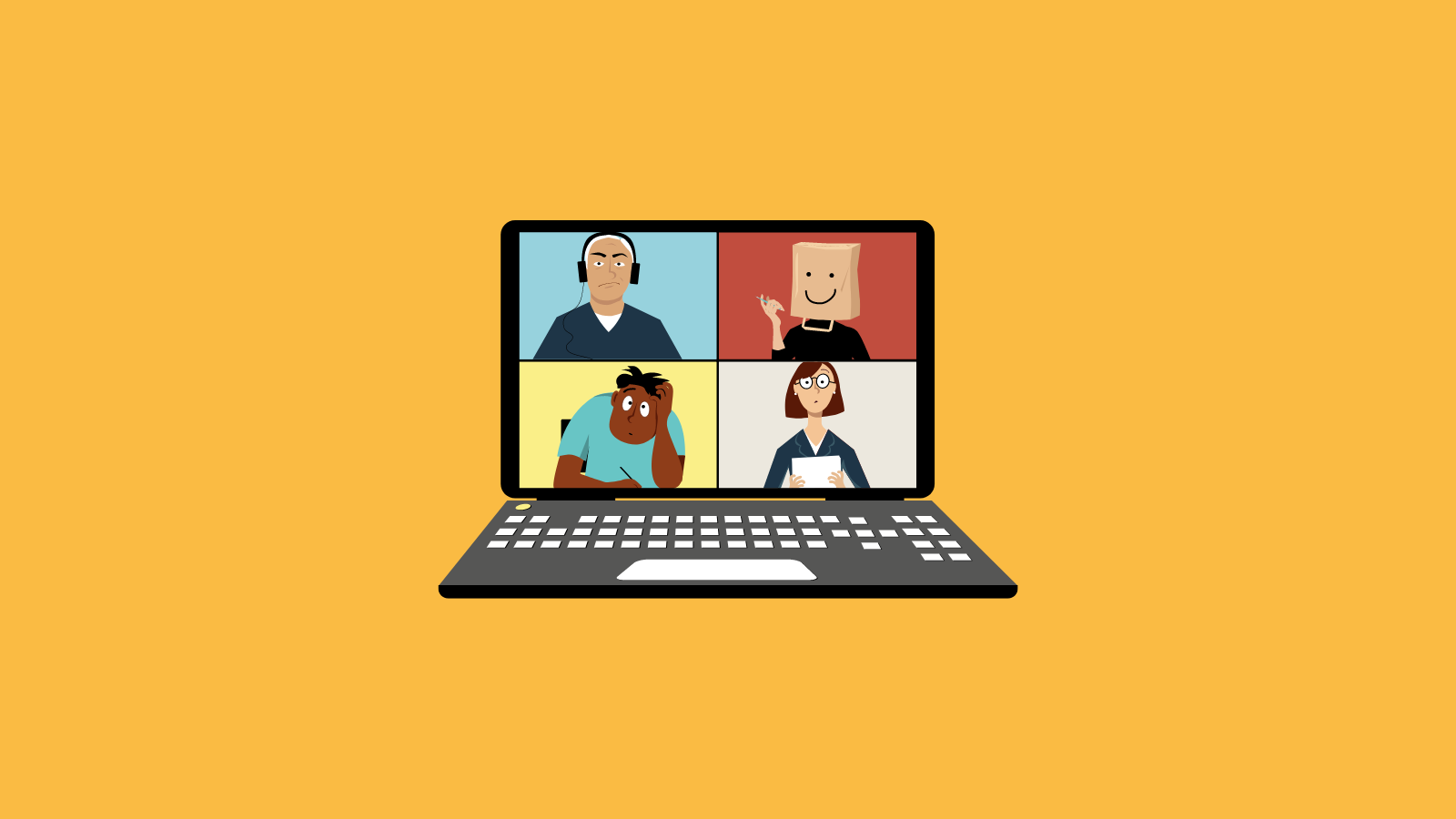Zoom Fatigue: How to Combat Meeting Fatigue (and Reclaim Your Day)

Are you experiencing Zoom fatigue? Want to learn more about it and discover how to minimize it?
You know - Being live on camera with other people takes a surprisingly heavy toll on our mental health.
Not only are we worrying about having to deliver our best ideas on the fly and struggling to remain present and focused — we’re likely wrestling with the discomfort of unnaturally prolonged eye contact and being overly conscious of how we look on screen or our facial expressions.
In short, Zoom fatigue is real.
It’s real for you, your colleagues, clients, and partners alike, and no one’s really immune to it.
Fighting off distractions and fretting about whether we’re contributing in a meaningful way — all while maintaining an appropriate presence for the camera — is incredibly draining.
And given such high levels of mental exhaustion can lead to low performance and irritability, it pays to take a closer look at how you can improve your company's communication and collaboration culture.
Newsflash! Live video calls can be high-stress environments.
The overwhelming feeling of having to “perform” for the camera is a significant drain on our resources. And Zoom fatigue is an undesirable side effect.
Recent studies have shown the worst offenders to be:
the abnormally prolonged simulation of close-up eye contact;
the mental strain of watching other attendees for visual cues;
a reduction in mobility from staying in the same spot; and
constantly seeing yourself in real-time
All of which can zap us of our energy and enthusiasm and leave us vulnerable to mental burnout.
But there are other (less tangible) downsides, too.
A day full of live, virtual meetings is emotionally draining
Anyone with a tendency towards self-criticism (which we’re more susceptible to the more tired we get) knows that our best ideas rarely show up on schedule.
This means that more often than not, during real-time sync-ups, we’re:
Combatting the stress of sharing (potentially) sub-par ideas;
Worrying about missed opportunities where we could have contributed but didn’t; and
Dealing with the regret of ending a call and suddenly thinking about 12 other (better) things we could have said in the moment.
So not only are we overworking the parts of our brain that help us concentrate — but we’re also battling the emotions that arise from self-doubt and our fear of not being good enough.
Thankfully, there are ways to combat this mental strain (which we’ll get to shortly.) But before we dig into some useful solutions, it can also help to reflect on other factors contributing to that overall sense of fatigue.
Zoom fatigue is real, but it’s not the only problem
The problem with a buzzword like “zoom fatigue” is that it can often mask a more extensive, underlying problem with how you operate throughout your day.
Any kind of mental fatigue can:
drain your energy levels,
impair critical thinking, and
profoundly affect your mood (which directly affects your productivity).
So reflecting on other areas of your life where you might be experiencing fatigue is essential to find the root of your exhaustion. Not to mention, it will help you build positive systems and practices for your team who may be experiencing similar side effects from their online work.
Two things to think about outside the realm of video-conferencing:
1. Life fatigue
Emotional and physical exhaustion are not exclusive to someone who has a ton of video calls. Taking on the burden of balancing work and life in a sustainable way (especially post-pandemic) means it’s going to take more than “turning the video off during a Zoom meeting” to get your energy back.
Multitasking and constant context switching (between work tasks, household chores, parenting, and everything in between) are massive culprits for causing stressful situations where your sense of control is compromised.
But scheduling breaks, carving out time for self-care, and leaning on your support system can help reduce the risk of running yourself ragged.
2. Screen fatigue
Extended use of a computer is a common cause of tiredness and loss of concentration.
Eye strain, body aches, dehydration — all play a part in how productive and energized you feel.
But simply taking short breaks to move away from your computer can be remarkably effective. And if you use that time to stretch, drink some water, and get your blood circulating with some extra steps — you’re body will love you for it.
You can also try the 20-20-20 rule: If you’re stuck sitting in front of a screen — every 20 minutes, look at something 20 feet away for 20 seconds. It helps reduce eye strain and mental fatigue.
3 Ways to Combat Zoom Fatigue and Promote Calm Collaboration
There is no doubt that if you’re managing a remote team or connecting with partners, colleagues and clients online — a day full of virtual meetings can cause extreme levels of mental exhaustion.
Whether it's zoom fatigue, meeting fatigue, or screen fatigue — it can all culminate in a variety of different problems your people have to deal with daily.
Not to mention the breakdown in communication (and hindrance to collaboration) which comes from relying too heavily on live conversations. After all, “getting on a quick call” rarely provides the chance for thoughtful feedback and prepared responses.
With that in mind, here are some practical ways to ease collaboration overload and promote a culture of calm and clear communication.
Key #1 — Break “Zoom Fatigue” with the async alternative for video meetings
Replacing real-time meetings with async conversations is the ultimate way to reduce fatigue and make your remote team more effective.
Of course, async communication is not a new phenomenon (hello, email!). But the emerging technology and tools available for remote-first companies have shed light on how unnecessary the live video conference call really is.
“Many companies—especially those making the transition from in-office to fully or partially remote—make the mistake of using frequent live meetings as a way to ensure the team stays productive while working remotely, when in fact, quite the opposite can happen.” — Brian Casel
Not only does an async approach to communication make dealing with timezone differences easier, but it also allows people to wield more autonomy over their day.
Gaining the time and mental freedom to collaborate and communicate on your own schedule has a tremendous impact on energy and performance. Not to mention that building async communication practices into your business leads to:
more space to receive, think, and prepare your best response;
promoting more positive outcomes and collaboration experiences;
happier teammates and happier clients, resulting in healthier working relationships that drive better results; and
improved knowledge management. Async messages are easier to store, refer back to, and put into action (whereas ideas shared in live Zoom calls get buried in a long conversation, rarely saved, and mostly forgotten.)
And, of course, less email. A coordinated and easily accessible conversation (say, in a threaded Clarityflow conversation) works better than playing a game of back-and-forth in your inbox.
The takeaway: Develop async processes and revert to them whenever possible. You won’t regret it!
Key #2 — Implement operational upgrades that can help fight meeting fatigue and help you claim back your day
Predictably, asynchronous communication can’t fix every people-management problem. But there are still many upgrades you can make to your collaboration and communication processes.
Here are five things to consider if you and your team are feeling bogged down by an overload of live video calls:
1. RETHINK WHETHER A MEETING IS NECESSARY AT ALL
Many companies have a lazy approach to their meeting protocols. Mainly because “it’s what we’ve always done” is easier than making fundamental shifts in how a team collaborates and gets things done.
But one of the easiest ways to reduce zoom fatigue and the time cost of having your entire team “sync up” — is to assess whether the meetings you have are necessary in the first place.
There is no doubt that live calls still have their place. For instance:
Meet and greet with a new teammate or contractor, build rapport, and help you gauge personality fit.
Virtual happy hours and hangouts can help create a more connected team environment (and ease the isolation that remote work can create)
Occasional sync-ups with clients can strengthen your business relationships.
But for the most part, async communication can (and should) be used to supplement many of these regular operations (e.g., feedback on work deliverables, edit requests, onboarding, and knowledge management.)
Reflecting on “what makes a necessary meeting” and establishing your own set of parameters around your answers is an excellent first step to creating healthier collaboration practices.
Three questions to pose and ponder:
Are meetings running efficiently? What would you change?
Who needs to be at individual meetings?
What meetings might not be necessary at all?
2. RUN NECESSARY MEETINGS MORE EFFECTIVELY (AND PROPOSE ASYNC OPTIONS FOR FUTURE COMMUNICATION)
Improving the live meetings you do have is an excellent way to protect your boundaries and respect other people’s time.
Some good rules of thumb for running a better live meeting:
Keep it short and structured with a clear agenda and transparent time limit. If you’re not running the meeting, ask the person who is for an agenda to help everyone stay on topic.
Identify cues for speaking, such as raising virtual hands. Or, if you have the capacity — have a moderator. This allows everyone to have their say and avoid confusion about who gets the mic and when.
Record and transcribe meetings that discuss projects and deliverables. Documenting anything that requires other people to weigh in later is a no-brainer. However, reviewing and structuring that documentation (so it’s actually helpful) is a necessary next step.
Allow for audio-only and turning off the camera (with the understanding that more than three people on an audio-only call likely means that most people in attendance won’t say anything and are better off reading the write-up later or listening to the recording.)
Propose an asynchronous alternative before signing off. When you finish a Zoom call, suggest collaborating asynchronously next time. You can also cut live calls short by addressing ideas, questions, and final thoughts in an asynchronous format. This gives everyone time to digest and formulate more thoughtful responses.
3. ADOPT THE WALKING MEETING AS AN ACTIVE ALTERNATIVE
Preventing the concentration and creativity decline that can arise from sitting at a desk (with distractions all-around) can transform the traditional live meeting.
The shift that we experience — from a passive to an active state of mind — bolsters creative thinking and can unleash a flow of ideas that being stuck in the office might not generate.
“There's this amazing thing about actually getting out of the box that leads to out-of-the-box thinking. Whether it's nature or the exercise itself, it certainly works.” — Nilofer Merchant
Better yet, you can have a walking meeting with someone else, or solo (where you pose a question to yourself).
The latter works incredibly well with an asynchronous model — as you’re giving yourself the space to explore and prepare a more thoughtful response to the problems you’re trying to solve.
You can record your thoughts as you go, or upon wrapping up your walk, sit down for a twenty-minute writing session to capture your ideas. And then organize them into something more valuable than an “on-the-fly” conversation.
Plus, you get to move your body and derive the benefits of being outside — both incredibly positive activities for boosting your well-being and fighting fatigue.
4. EXPERIMENT WITH VIRTUAL TEAM CO-WORKING SESSIONS TO PROMOTE UNINTERRUPTED DEEP WORK SESSIONS
Creating collaboration opportunities that promote deep work (rather than interrupt it) can help boost your team’s productivity and make everyone work harder. As well as ease the isolation that working remotely can trigger.
Your team benefits from scheduled, uninterrupted time to work on important tasks and projects (with built-in accountability). And gain the option to catch up informally on either side of the session.
I happen to run virtual coworking sessions every week within a membership community for writers and online business owners. Without fail — in every session, someone remarks how profoundly helpful it is to schedule that time in their calendar.
5. INTRODUCE MEETING QUOTAS TO MINIMIZE BURNOUT
Another way to limit meetings and reduce Zoom fatigue is to place some positive constraints on the number of live sessions you and your team can schedule each week.
As Cal Newport suggests:
“Give each person three-afternoon slots every day for meetings, and that’s it; so once you’ve filled the slots for a given day, you have to move on to another day, enforcing an artificial scarcity on collaborative attention and ensuring enough focus is left over for other types of work.”
Key #3 — Empower your colleagues, clients, and collaborators with these six tips for stress-free Zoom calls:
Despite the massive benefits that an async-first approach can bring to your remote company, there is no doubt that sometimes live calls are necessary.
But you can avoid the pitfalls of Zoom fatigue (and help your teammates feel more comfortable on cam) with these six tips:
1. Turn off self-view. This is an easy fix for the “I hate looking at myself” crowd. And will allow for more focus and engagement with the other people on the call.
2. Create a pre-meeting ritual. Before any meeting, use a ritual to get you geared up and ready to go. Blast some music, dance around, do 25 push-ups, 100 jumping jacks — anything that can refresh your psychological state so you can think clearly and concentrate better.
3. Use some of these tips to feel better about being on camera. The people who feel natural on the camera have usually practiced (a lot) to get to that comfort level. Don’t shy away from arming yourself with tricks and hacks for improving your “performance.”
4. Reduce multitasking and make a conscious effort to be present. A surefire way to disrupt your attention is to give yourself options to do so. Close browser tabs, shut off your email, and tidy your desk of papers and unfinished tasks. You can even turn on do-not-disturb on your devices. Counteract the tendency toward distraction by preparing for meetings with a more “present” mindset. As my friend Amanda mentioned:
“Oddly enough, when I put more effort into a Zoom call (being fully present, my most empathetic self, etc.), I find myself emerging more energized.”
5. Use intentional, physical distractions to help stay alert. Though the jury is out on whether fidget spinners and sensory toys are proven methods for maintaining concentration — anecdotal evidence suggests they may help! Stress balls, sensory putty, fidget rings can help keep your hands occupied. Taking notes works, too (even if no one ever reads them.)
6. Build-in breaks that allow you to move, hydrate and reset. Yep, we’re repeating this one, because it’s vital to give yourself and your team the space to regroup, refresh, and re-concentrate.
Zoom fatigue can cause burnout and communication breakdown, but you can fight it!
Given that:
Live video calls can magnify social anxiety
Too many meetings = no control or agency over the day
There is high stress involved with transitioning between sessions, and
Unproductive context switching reduces natural flow states
It makes sense to rethink how you communicate with your various collaborators to minimize mental fatigue and drive more positive results regarding productivity, performance, and creative thinking.
And of all the techniques mentioned today, by far the most effective way to protect your time, respect your team's boundaries, and get the most important things done — is to adopt an asynchronous-first approach when it comes to your online collaboration.
Leading with a clear set of async practices (which you can continue developing and refining as you go) lends itself to eliminating the exhaustion that unnecessary real-time meetings can create.
Consider using Clarityflow as an alternative to your next Zoom call and gain an immediate reduction in meeting-fueled stress. In addition to driving superior results from your company's collaboration efforts.



